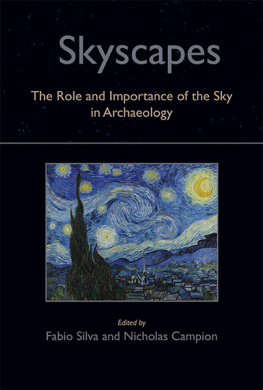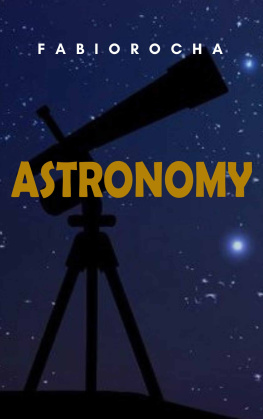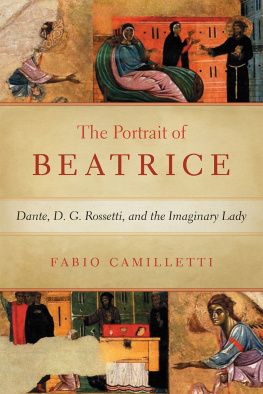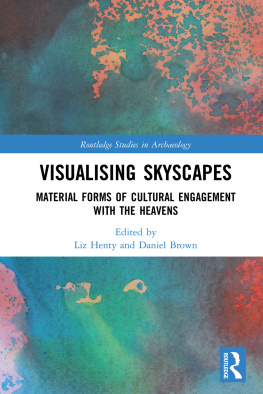Silva Fabio - Skyscapes
Here you can read online Silva Fabio - Skyscapes full text of the book (entire story) in english for free. Download pdf and epub, get meaning, cover and reviews about this ebook. year: 2015, publisher: Oxbow Books, Limited, genre: Romance novel. Description of the work, (preface) as well as reviews are available. Best literature library LitArk.com created for fans of good reading and offers a wide selection of genres:
Romance novel
Science fiction
Adventure
Detective
Science
History
Home and family
Prose
Art
Politics
Computer
Non-fiction
Religion
Business
Children
Humor
Choose a favorite category and find really read worthwhile books. Enjoy immersion in the world of imagination, feel the emotions of the characters or learn something new for yourself, make an fascinating discovery.
- Book:Skyscapes
- Author:
- Publisher:Oxbow Books, Limited
- Genre:
- Year:2015
- Rating:5 / 5
- Favourites:Add to favourites
- Your mark:
- 100
- 1
- 2
- 3
- 4
- 5
Skyscapes: summary, description and annotation
We offer to read an annotation, description, summary or preface (depends on what the author of the book "Skyscapes" wrote himself). If you haven't found the necessary information about the book — write in the comments, we will try to find it.
Skyscapes — read online for free the complete book (whole text) full work
Below is the text of the book, divided by pages. System saving the place of the last page read, allows you to conveniently read the book "Skyscapes" online for free, without having to search again every time where you left off. Put a bookmark, and you can go to the page where you finished reading at any time.
Font size:
Interval:
Bookmark:
Published in the United Kingdom in 2015 by
OXBOW BOOKS
10 Hythe Bridge Street, Oxford OX1 2EW
and in the United States by
OXBOW BOOKS
908 Darby Road, Havertown, PA 19083
Oxbow Books and the individual contributors 2015
Paperback Edition: ISBN 978-1-78297-840-4
Digital Edition: ISBN 978-1-78297-841-1; Mobi Edition: ISBN 978-1-78297-842-8;
PDF Edition: ISBN 978-1-78297-843-5
A CIP record for this book is available from the British Library
Library of Congress Cataloging-in-Publication Data
Library of Congress Cataloging-in-Publication Data
Skyscapes : the role and importance of the sky in archaeology / edited by Fabio Silva and Nicholas
Campion.
1 online resource.
Includes bibliographical references.
Description based on print version record and CIP data provided by publisher; resource not viewed.
ISBN 978-1-78297-841-1 (epub) -- ISBN 978-1-78297-842-8 (prc) -- ISBN 978-1-78297-843-5 ( pdf)
-- ISBN 978-1-78297-840-4 (paperback) 1. Archaeoastronomy. 2. Landscape archaeology. 3. Sky
-Social aspects--History. 4. Cosmology--History. 5. Astrology--History. 6. Sacred space--History. 7.
Prehistoric peoples. 8. Social archaeology. I. Silva, Fabio (Fabio P.) II. Campion, Nicholas.
GN799.A8
523.1--dc23
2015007231
All rights reserved. No part of this book may be reproduced or transmitted in any form or by any
means, electronic or mechanical including photocopying, recording or by any information storage and
retrieval system, without permission from the publisher in writing.
Printed in the United Kingdom by Short Run Press, Exeter
For a complete list of Oxbow titles, please contact:
| UNITED KINGDOM | UNITED STATES OF AMERICA |
| Oxbow Books | Oxbow Books |
| Telephone (01865) 241249, Fax (01865) 794449 | Telephone (800) 791-9354, Fax (610) 853-9146 |
| Email: | Email: |
| www.oxbowbooks.com | www.casemateacademic.com/oxbow |
Oxbow Books is part of the Casemate Group
Front cover: Vincent Van Goghs Starry Night, 1889. Museum of Modern Art, New York, USA/Bridgeman Images
CONTENTS
J. McKim Malville
Fabio Silva
Nicholas Campion
Liz Henty
Daniel Brown
Lionel Sims
Tore Lomsdalen
Bernadette Brady
Frank Prendergast
Olwyn Pritchard
Fabio Silva
Timothy Darvill
LIST OF CONTRIBUTORS
BERNADETTE BRADY
Sophia Centre for the Study of Cosmology in Culture,
School of Archaeology, History and Anthropology University of Wales Trinity Saint David, UK
DANIEL BROWN
Physics and Mathematical Science,
School of Science and Technology Nottingham Trent University, UK
NICHOLAS CAMPION
Sophia Centre for the Study of Cosmology in Culture,
School of Archaeology, History and Anthropology University of Wales Trinity Saint David, UK
TIMOTHY DARVILL
Department of Archaeology and Anthropology,
Faculty of Science and Technology Bournemouth University, UK
LIZ HENTY
Sophia Centre for the Study of Cosmology in Culture,
School of Archaeology, History and Anthropology University of Wales Trinity Saint David, UK
TORE LOMSDALEN
Independent scholar
J. MCKIM MALVILLE
Astrophysical and Planetary Sciences University of Colorado Boulder, USA
FRANK PRENDERGAST
College of Engineering & Built Environment Dublin Institute of Technology, Ireland
OLWYN PRITCHARD
School of Archaeology, History and Anthropology University of Wales Trinity Saint David, UK
FABIO SILVA
Sophia Centre for the Study of Cosmology in Culture,
School of Archaeology, History and Anthropology University of Wales Trinity Saint David, UK
and Institute of Archaeology University College London, UK
LIONEL SIMS
School of Law and Social Sciences University of East London, UK
PREFACE
Meaning and Intent in Ancient Skyscapes An Andean Perspective
J. McKim Malville
The Search for Meaning
The papers in this volume deal mostly with prehistoric archaeoastronomy in the Old World, for which there is little or no ethnographic or ethnohistoric material that can assist in the interpretation of findings. This lack was initially contrasted with the situation in Mesoamerica for which there was rich ethnographic information and led to the distinction between Old World and New World archaeoastronomy, initially codified by Aveni (1989) as green (European) versus brown (American) archaeoastronomy.
That distinction is less cogent today, as archaeoastronomy in the Americas has expanded into areas and time slots where there is also a lack of ethnographic material, such as Cahokia (Illinois), Chaco Canyon (New Mexico), and Peru. For example, the archaeologist Steve Lekson (2008) has vigorously argued that the Chaco Canyon culture was an unsuccessful experiment, which was abandoned by the ancestors of todays Puebloan peoples, and therefore one cannot use Puebloan ethnography to understand the nature of Chacoan culture. In the case of Peru, millennia of pre-Inca Andean culture lie far beyond the reach of the Spanish Chroniclers and their writings. The ethnographic record is similarly mute and one must rely upon thorough investigations of the archaeological record to probe cultural context and meaning.
An ever-present question in cultural astronomy and archaeoastronomy is why were events in the heavens so powerful and meaningful to ancient cultures that they caused the investment of energy and wealth in the construction of stone structures aligned to astronomical phenomena. The ethnographic approach known as thick descriptions of human behavior, championed by the anthropologist Clifford Geertz (1973, 1983), can help us in our search for meaning contained in ancient skyscapes. Thick description emphasizes the emic (as opposed to etic) significance of social action and seeks an explanation. Applied to archaeoastronomy, thick descriptions should lead to using astronomical markers as signifiers of processes and meaning within that culture. As Geertz (1983, 58) comments, The trick is to figure out what the devil they think they are up to. Thick description is clearly a task, at least as delicate, if a bit less magical, as putting oneself into some elses skin. Geertzs (1983, 50).
To reach an understanding of those cultural processes that manifest as astronomical alignments, we need a multi-disciplinary approach. Limiting ourselves only to astronomy will never fully reveal the cultural complexity of a site. Not only must we work with our archaeologist colleagues, but we need to collaborate, when possible, with cultural anthropologists, linguists, ethno-historians, and even paleo-hydrologists. Furthermore, archaeoastronomers need to investigate multiple aspects of the archaeological record, even if they do not contain obvious astronomical elements. In his introduction to the proceedings of the Oxford IX conference in Lima (Peru), Ruggles (2011, 7) alludes to this kind of a holistic research programme: the archaeoastronomer not only has to focus on broader cultural questions but also has to have sufficient genuine interest in these broader questions not to become demotivated if the data start to produce non-astronomical answers. In a recent paper Silva has mirrored this by arguing for a stronger archaeological and cultural contextualization of archaeoastronomical work, something he called skyscape archaeology (2014, 25).
Different Ontologies
Meaning and intent embedded in ancient skyscapes may reveal a totally different understanding of reality, a different ontology. The so-called ontological turn in anthropology can provide new tools in our search for meaning (Henare
Next pageFont size:
Interval:
Bookmark:
Similar books «Skyscapes»
Look at similar books to Skyscapes. We have selected literature similar in name and meaning in the hope of providing readers with more options to find new, interesting, not yet read works.
Discussion, reviews of the book Skyscapes and just readers' own opinions. Leave your comments, write what you think about the work, its meaning or the main characters. Specify what exactly you liked and what you didn't like, and why you think so.












